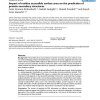Free Online Productivity Tools
i2Speak
i2Symbol
i2OCR
iTex2Img
iWeb2Print
iWeb2Shot
i2Type
iPdf2Split
iPdf2Merge
i2Bopomofo
i2Arabic
i2Style
i2Image
i2PDF
iLatex2Rtf
Sci2ools
BMCBI
2008
2008
Impact of residue accessible surface area on the prediction of protein secondary structures
Background: The problem of accurate prediction of protein secondary structure continues to be one of the challenging problems in Bioinformatics. It has been previously suggested that amino acid relative solvent accessibility (RSA) might be an effective factor for increasing the accuracy of protein secondary structure prediction. Previous studies have either used a single constant threshold to classify residues into discrete classes (buries vs. exposed), or used the real-value predicted RSAs in their prediction method. Results: We studied the effect of applying different RSA threshold types (namely, fixed thresholds vs. residue-dependent thresholds) on a variety of secondary structure prediction methods. With the consideration of DSSP-assigned RSA values we realized that improvement in the accuracy of prediction strictly depends on the selected threshold(s). Furthermore, we showed that choosing a single threshold for all amino acids is not the best possible parameter. We therefore used...
| Added | 09 Dec 2010 |
| Updated | 09 Dec 2010 |
| Type | Journal |
| Year | 2008 |
| Where | BMCBI |
| Authors | Amir Momen-Roknabadi, Mehdi Sadeghi, Hamid Pezeshk, Sayed-Amir Marashi |
Comments (0)

